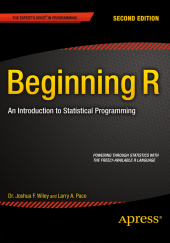 Neuerscheinungen 2015Stand: 2020-02-01 |
Schnellsuche
ISBN/Stichwort/Autor
|
Herderstraße 10
10625 Berlin
Tel.: 030 315 714 16
Fax 030 315 714 14
info@buchspektrum.de |

Larry Pace, Joshua Wiley
(Beteiligte)
Beginning R
An Introduction to Statistical Programming
2. Aufl. 2015. xxiii, 327 S. 168 SW-Abb. 254 mm
Verlag/Jahr: SPRINGER, BERLIN; APRESS 2015
ISBN: 1-484-20374-7 (1484203747)
Neue ISBN: 978-1-484-20374-3 (9781484203743)
Preis und Lieferzeit: Bitte klicken
Beginning R, Second Edition is a hands-on book showing how
to use the R language, write and save R scripts, read in data files, and write
custom statistical functions as well as use built in functions. This book shows
the use of R in specific cases such as one-way ANOVA analysis, linear andlogistic regression, data visualization, parallel processing, bootstrapping,
and more. It takes a hands-on, example-based approach incorporating best
practices with clear explanations of the statistics being done. It has been
completely re-written since the first edition to make use of the latest
packages and features in R version 3.
R is a powerful open-source language and programming
environment for statistics and has become the de facto standard for doing,
teaching, and learning computational statistics. R is both an object-oriented language and a
functional language that is easy to learn, easy to use, and completely free. A
large community of dedicated R users and programmers provides an excellent
source of R code, functions, and data sets, with a constantly evolving
ecosystem of packages providing new functionality for data analysis. R has also
become popular in commercial use at companies such as Microsoft, Google, and
Oracle. Your investment in learning R is sure to pay off in the long term as R
continues to grow into the go to language for data analysis and research.
What You Will Learn:
How to acquire and install R
Hot to import and export data and scripts
How to analyze data and generate graphics
How to program in R to write custom functions
Hot to use R for interactive statistical explorations
How to conduct bootstrapping and other advanced
techniques
Part I. Learning the R Language
1. Getting Started
2. Dealing with Dates, Strings, and Data Frames
3. Input and Output
4. Control Structures
Part II. Using R for Descriptive Statistics
5. Functional Programming
6. Probability Distributions
7. Working with Tables
Part III. Using R for Inferential Statistics
8. Descriptive Statistics and Exploratory Data Analysis
9. Working with Graphics
10. Traditional Statistical Methods
11. Modern Statistical Methods
12. Analysis of Variance
13. Correlation and Regression
14. Multiple Regression
15. Logistic Regression
16. Modern Statistical Methods II
Part IV. Taking R to the Next Level
17. Data Visualization Cookbook
18. High-performance Computing
19. Text Mining
Dr. Larry Pace is a statistics author and educator, as well as a consultant. He lives in the upstate area of South Carolina in the town of Anderson. He is a professor of statistics, mathematics, psychology, management, and leadership. He has programmed in a variety of languages and scripting languages including R, Visual Basic, JavaScript, C##, PHP, APL, and in a long-ago world, Fortran IV. He writes books and tutorials on statistics, computers, and technology. He has also published many academic papers, and made dozens of presentations and lectures. He has consulted with Compaq Computers, AT&T, Xerox Corporation, the U.S. Navy, and International Paper. He has taught at Keiser University, Argosy University, Capella University, Ashford University, Anderson University (where he was the chair of the behavioral sciences department), Clemson University, Louisiana Tech University, LSU in Shreveport, the University of Tennessee, Cornell University, Rochester Institute of Technology, Rensselaer Polytechnic Institute, and the University of Georgia.


